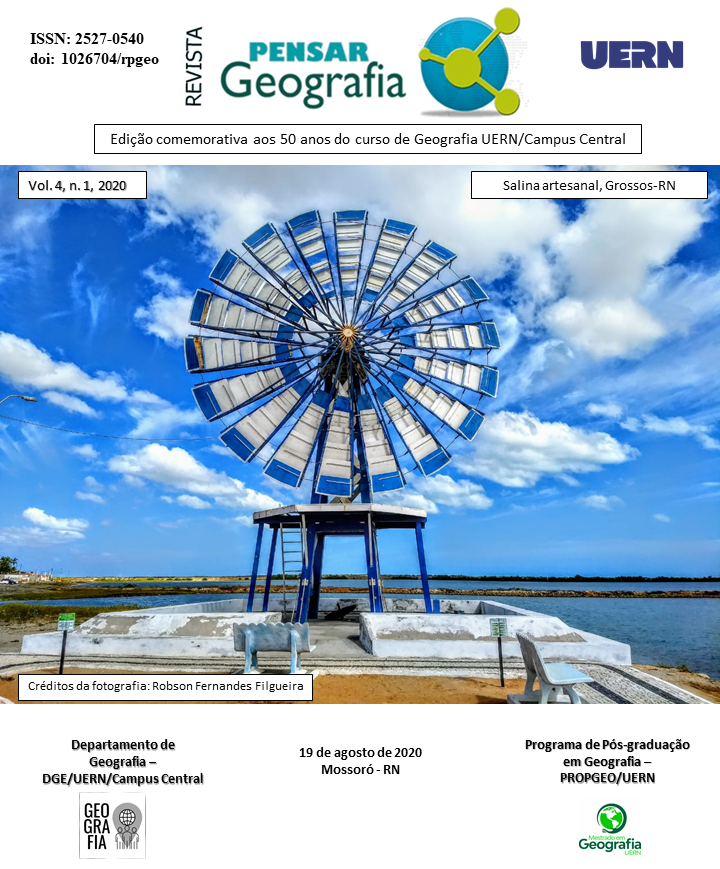Abordagens geográficas sobre o turismo
DOI:
https://doi.org/10.26704/pgeo.v4i1.2133Palavras-chave:
Geografia do Turismo, Turismo, abordagens geográficas do turismoResumo
O turismo é setor que tem se destacado anualmente, em 2016 movimentou 1.235 milhões de turistas em todo mundo gerando US$ 1,4 trilhões em exportações turísticas (UNWTO, 2017). O turismo contemporâneo surgiu do grand tour evoluindo a partir das transformações técnica-científicas vivenciadas pelo período capitalista, possibilitando que o turismo fosse realizado também pela classe média trabalhadora, dando origem ao turismo de massa e aos grandes fluxos turísticos pelo mundo, desta forma o turismo não é apenas um fenômeno econômico, mas multidisciplinar, envolvendo várias áreas do conhecimento, inclusive a geográfica. O presente artigo tem como objetivo discutir, pelo viés geográfico, o turismo de sua invenção no mundo contemporâneo. A análise do turismo pela geografia é realizada a partir de uma diversidade de olhares e percepções do espaço geográfico transformado pelo turismo ao redor do mundo, dessa forma, a Geografia do Turismo não deve ser considerada como uma nova geografia, autônoma e linear, mas como uma área temática dentro da ciência geográfica, que busca apreender esse fenômeno de acordo com uma ou outra linha epistêmica da geografia, como a perspectiva neopositivista, marxista, humanista ou da complexidade. Entendemos também que ainda há muito a ser discutido sobre o turismo na ciência geográfica e que esse trabalho possa contribuir no decorrer desse diálogo
Downloads
Referências
BARROS, N. Por que as destinações turiÌsticas no Nordeste do Brasil não declinam? Recife: Editora UniversitaÌria UFPE. 2009.
BOYER, M; Ribeiro, V. HistoÌria do turismo de massa. Bauru: EDUSC. 2003.
BUTLER, R. The concept of a tourist area cycle of evolution: implications for management of resources. The Canadian Geographer/Le Géographe canadien, 24(1), 1980, pp.5-12.
______. Geographical research on tourism, recreation and leisure: origins, eras and directions. Tourism Geographies, 6(2), 2004, pp.143-162.
CADENA, I. La urbanización turística como "˜solución espacial"™. agentes, planeamiento y propiedad em la playa de Palma y Magaluf (Mallorca). Doutor. Universitat de les illes Balears. 2015.
CASTRO, N. O lugar do turismo na ciência geográfica: contribuições teórico-metodológicas à ação educativa. Doutor. Universidade de São Paulo, 2006
CORBIN, A. O territorio do vazio. São Paulo (SP): Companhia das Letras, 1989.
CORIOLANO, L; Silva, S. Turismo e geografia. Fortaleza: Ed. UECE, 2005
CRUZ, R. Geografias do turismo: De lugares a pseudo-lugares. São Paulo: Roca, 2012.
DAMIANI, A. Turismo e lazer em espaços urbanos. In: A. RODRIGUES (Org.). Turismo Modernidade e Globalização. São Paulo: Hucitec, 2002, pp.46-54.
DEWAILLY, J. Complexité touristique et approche transdisciplinaire du tourisme. Téoros. N.27(1), 2006 ,pp.22-26.
______. Tourisme et geÌographie, entre peÌreÌgriniteÌ et chaos? Paris [etc.]: L'Harmattan, 2008
ÉQUIPE MIT. Tourisme 2: Moments de lieux. Paris: Belin, 2005
____. Tourisme 1: Lieux touristique. Paris: Belin, 2008.
Gravari-Barbas, M; Jacquot, S. Les géographes et les métiers du tourisme. EchoGéo. N.19, 2012.
Knafou, R. et al Une approche géographique du tourisme. Espace géographique, 26(3), 1997, p. 193-204.
Krakover, S. Time dimension and tourism development in Peripheral Areas. In: S. KRAKOVER; Y. GRADUS (Org.). Tourism in Frontier Areas. Lanham: Lexington Books, 2002, pp.21-37.
Lazzarotti, O. La géographie dans la controverse touristique. Annales de Géographie. 103(580), 1994, pp.627-650.
Miossec, J. L'image touristique comme introduction à la géographie du tourisme. Annales de Géographie. 86(473), 1977a pp.55-70.
_____. Un modèle de l'espace touristique. Espace géographique. 6(1), 1977b, pp.41-48.
MORIN, Edgar. El método I. La naturaleza de la naturaleza. Cátedra. Madrid. 1981.
Nicolás, D. Elementos para un analisis sociogeográfico del turismo. In: A. Rodrigues, (Org). Turismo e geografia: reflexões teóricas e enfoques regionais. 2nd ed. São Paulo: Hucitec, 1999, pp.39-54.








